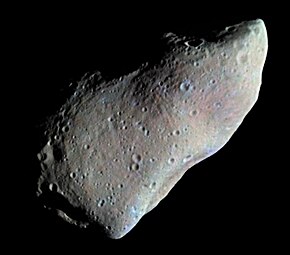 Galileo image of Gaspra; colors are exaggerated | |
| Discovery[1][2] | |
|---|---|
| Discovered by | G. Neujmin |
| Discovery site | Simeiz Obs. |
| Discovery date | 30 July 1916 |
| Designations | |
| (951) Gaspra | |
| Pronunciation | /ˈɡæsprə/ |
Named after | Gaspra[3] (Crimean spa town) |
| 1916 S45 · 1916 Σ45 SIGMA 45 · A913 YA 1955 MG1 | |
| main-belt · (inner) Flora[4] | |
| Orbital characteristics[1] | |
| Epoch 4 September 2017 (JD 2458000.5) | |
| Uncertainty parameter 0 | |
| Observation arc | 103.54 yr (37,819 days) |
| Aphelion | 2.5931 AU |
| Perihelion | 1.8267 AU |
| 2.2099 AU | |
| Eccentricity | 0.1734 |
| 3.29 yr (1,200 days) | |
| 232.83° | |
| 0° 18m 0s / day | |
| Inclination | 4.1063° |
| 253.06° | |
| 129.94° | |
| Physical characteristics | |
| Dimensions | 18.2 km × 10.5 km × 8.9 km[5] 12.2 km (mean diameter)[1] |
| Mass | 2–3 × 1015 kg (estimate) |
Mean density | ~2.7 g/cm3 (estimate)[6] |
| 7.042 h (0.293 d)[1] | |
| 72°[5] | |
| 0.246±0.032[1] | |
| Tholen = S[1] SMASS = S[1] B–V = 0.870[1] U–B = 0.554[1] | |
| 11.46[1] | |
951 Gaspra is an S-type asteroid that orbits very close to the inner edge of the asteroid belt. Gaspra was discovered by Russian astronomer G. N. Neujmin in 1916. Neujmin named it after Gaspra, a Black Sea retreat that was visited by his contemporaries, such as Gorky and Tolstoy.
Gaspra was the first asteroid ever to be closely approached when it was visited by the Galileo spacecraft, which flew by on its way to Jupiter on 29 October 1991.[7]
- ^ a b c d e f g h i j Cite error: The named reference
jpldatawas invoked but never defined (see the help page). - ^ Cite error: The named reference
MPC-objectwas invoked but never defined (see the help page). - ^ Cite error: The named reference
springerwas invoked but never defined (see the help page). - ^ Cite error: The named reference
Ferretwas invoked but never defined (see the help page). - ^ a b Cite error: The named reference
Thomas94was invoked but never defined (see the help page). - ^ Cite error: The named reference
Krasinskywas invoked but never defined (see the help page). - ^ Cite error: The named reference
Belton92was invoked but never defined (see the help page).